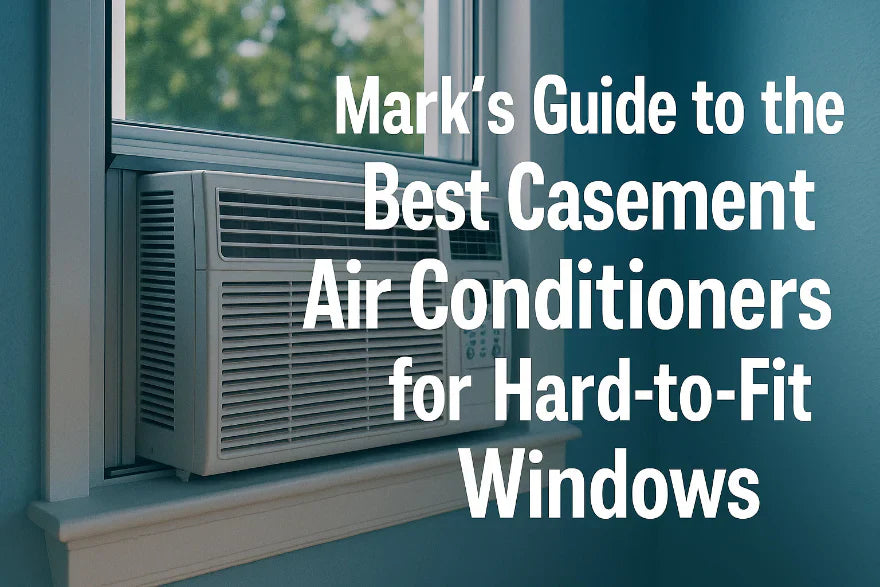👋 Hey there, homeowner!
Mark here—your friendly neighborhood HVAC installer with 20+ years in the field, and today we’re talking about a weirdly specific—but super important—topic: casement air conditioners.
If you’ve got crank-style windows (aka casement or sliding windows that open outward), you’ve probably already discovered that standard window ACs just won’t cut it. You’re not alone—lots of older homes, basements, and even modern designs use casement windows. And cooling these spaces? Not so simple.
That’s where casement AC units come in. They’re tall, narrow, and designed specifically to fit these windows without all the hassle. Let’s break down what makes a good one—and how to find the right size, BTU, and energy efficiency to beat the heat. ☀️🛠️
🧱 Why Standard Window ACs Don’t Work for Crank Windows
Typical window ACs are short and wide—designed for double-hung windows that slide up and down. Casement windows swing outward like a door, which means:
-
No ledge to rest a traditional unit on
-
No upper sash to clamp down and seal it
-
A greater risk of poor fit, air leaks, or worse—unit tipping out! 😬
👉 Casement air conditioners (sometimes called vertical ACs) are built tall and narrow to solve that problem. They fit safely and seal properly, and they often come with custom installation kits to adapt to your unique frame.
⚖️ Choosing the Right Casement AC for Your Room
Here’s what I recommend looking for:
✅ 1. Correct BTU Rating (Don’t Oversize!)
-
For small bedrooms or home offices (150–300 sq. ft.), go for 8,000–10,000 BTUs
-
For mid-sized living spaces (300–500 sq. ft.), you’ll want 10,000–12,000 BTUs
🔗 Want to calculate it precisely? Use the U.S. Department of Energy’s BTU Sizing Guide to get it right.
If you oversize, it’ll short-cycle and leave the room muggy. Too small? You’ll run it all day with no relief.
✅ 2. Energy Efficiency (Save on Bills)
Look for units with:
-
ENERGY STAR® certification
-
CEER (Combined Energy Efficiency Ratio) of 9.8 or higher
🔗 Energy Star’s AC Buying Guide is a great place to compare efficiency ratings.
Higher CEER = lower electric bills and less strain on the unit.
✅ 3. Casement-Friendly Features
The best casement air conditioners have:
-
Tall, narrow frame (to fit crank window opening)
-
Strong mounting kit and side filler panels
-
Remote control + programmable timer
-
Drain option for continuous operation (important in humid areas!)
And if you're looking at a casement air conditioner with 12,000 BTU, be sure your electrical outlet supports the right amperage—some of the bigger ones require 115V or even 230V circuits. 🔌
🧰 Installation Tips From Mark
Installing a casement unit can be a bit trickier than the classic drop-in window AC. Here’s what I’ve learned the hard way:
-
Seal all gaps with weatherstripping or insulation foam
-
Use the included support bracket—don’t skip this step
-
Always tilt the unit slightly downward toward the outside for drainage
-
If your window opens too narrow, you may need to remove the sash completely
🔗 The Family Handyman's Casement AC Installation Guide is one of the clearest walk-throughs I’ve seen.
🏆 Mark’s Picks: Best Casement ACs in 2025
Here are some brands and models I trust in the field:
-
Frigidaire FFRS1022R1
-
10,000 BTU
-
CEER 10.4
-
Great for small–mid rooms
-
Easy install kit, remote included
-
Low-profile, quiet operation
-
-
Keystone KSTSW10A
-
10,000 BTU
-
ENERGY STAR
-
Dehumidifier mode (great in basements)
-
-
PerfectAire 3PASC10000
-
10,000 BTU
-
Best fit for very narrow windows
-
🔗 Want more tech specs? Check out the Consumer Reports air conditioner ratings for unbiased lab-tested performance.
🔁 TL;DR (Too Long; Didn't Read) – The Quick Fix for Crank Windows
-
Casement ACs are made for vertical, crank-out windows
-
Get the right BTU for your room size
-
Look for ENERGY STAR and solid install kits
-
Check models like Frigidaire, Keystone, and PerfectAire
-
They’re pricier than traditional units, but way more effective for the job
🔌 Mark’s Plug & Play Recap
Look—just because you’ve got crank windows doesn’t mean you have to sweat through the summer. A casement air conditioner is the right tool for the job, and the good ones are built to last.
They might cost a little more than traditional window units, but the peace of mind, safe install, and real cooling power are worth every penny. Plus, you avoid the ductwork, the demo, and the crazy power bills that come with other systems.
And if you’ve got more than one room to cool—or want something even sleeker and whisper-quiet—take a peek at The Furnace Outlet’s guide to 2.5-ton smart cooling systems. There’s a whole world of ductless options waiting.
Good plugs, good power, good peace of mind.
🔋 — Mark







